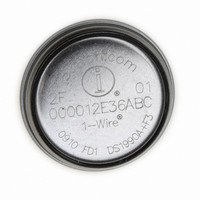DS1922T-F5# Maxim Integrated Products, DS1922T-F5# Datasheet - Page 22

DS1922T-F5#
Manufacturer Part Number
DS1922T-F5#
Description
IBUTTON TEMP LOGGER
Manufacturer
Maxim Integrated Products
Series
iButton®r
Datasheet
1.DS1922L-F5.pdf
(52 pages)
Specifications of DS1922T-F5#
Rohs Information
IButton RoHS Compliance Plan
Memory Size
512B
Memory Type
NVSRAM (Non-Volatile SRAM)
Lead Free Status / RoHS Status
Lead free / RoHS Compliant
Temperature Logger iButton with 8KB
Data-Log Memory
The DS1922L/DS1922T are set up for operation by writ-
ing appropriate data to the special function registers,
which are located in the two register pages. The set-
tings in the Mission Control register determine which
format (8 or 16 bits) applies and whether old data can
be overwritten by new data once the data-log memory
is full. An additional control bit can be set to tell the
DS1922L/DS1922T to wait with logging data until a tem-
perature alarm is encountered.
Bit 5: Start Mission Upon Temperature Alarm
(SUTA). This bit specifies whether a mission begins
immediately (includes delayed start) or if a temperature
alarm is required to start the mission. If this bit is 1, the
device performs an 8-bit temperature conversion at the
selected sample rate and begins with data logging only
if an alarming temperature (high alarm or low alarm)
was found. The first logged temperature is when the
alarm occurred. However, the mission sample counter
does not increment. This functionality is guaranteed by
design and not production tested.
Note: During a mission, there is only read access to this register. Bits 6 and 7 have no function. They always read 1 and cannot be
written to 0. Bits 1 and 3 control functions that are not available with the DS1922L/DS1922T. Bit 1 must be set to 0. Under this condi-
tion the setting of bit 3 becomes a “don’t care.”
22
ADDRESS
0213h
______________________________________________________________________________________
BIT 7
1
BIT 6
1
Mission Control
SUTA
BIT 5
BIT 4
RO
Bit 4: Rollover Control (RO). This bit controls whether,
during a mission, the data-log memory is overwritten
with new data or whether data logging is stopped once
the data-log memory is full. Setting this bit to 1 enables
the rollover and data logging continues at the begin-
ning, overwriting previously collected data. If this bit is
0, the logging and conversions stop once the data-log
memory is full. However, the RTC continues to run and
the MIP bit remains set until the Stop Mission command
is performed.
Bit 2: Temperature Logging Format Selection
(TLFS). This bit specifies the format used to store tem-
perature readings in the data-log memory. If this bit is
0, the data is stored in 8-bit format. If this bit is 1, the
16-bit format is used (higher resolution). With 16-bit for-
mat, the most significant byte is stored at the lower
address.
Bit 0: Enable Temperature Logging (ETL). To set up
the device for a temperature-logging mission, this bit
must be set to logic 1. The recorded temperature val-
ues start at address 1000h.
BIT 3
(X)
Mission Control Register Bitmap
TLFS
BIT 2
BIT 1
0
BIT 0
ETL












